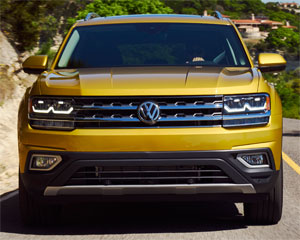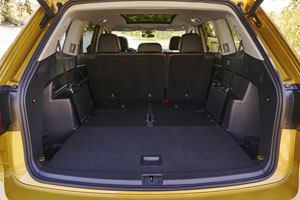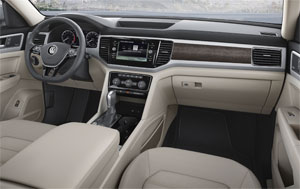2018 Volkswagen Atlas
When Volkswagen opened up a plant in Chattanooga, Tennessee; to build a new Passat sedan; everyone assumed that car was just first of things to come. Well, that was 6 years ago! now, finally, we get to see VW’s second effort from the “dynamo of dixie”, the largest utility the brand has ever made; and designed specifically for the American family; the Atlas!
 Back when the 2018 Volkswagen Atlas was going through its early design stages, VW must have been nervous about where the SUV market was headed. It turns out, they needn’t have worried, as utility sales continue to escalate like it’s 1999 all over again. And Atlas appears to be exactly the right vehicle that Volkswagen needs.
Back when the 2018 Volkswagen Atlas was going through its early design stages, VW must have been nervous about where the SUV market was headed. It turns out, they needn’t have worried, as utility sales continue to escalate like it’s 1999 all over again. And Atlas appears to be exactly the right vehicle that Volkswagen needs.
This 3-row, 7-passenger, approaching full-size crossover, is longer outside and roomier inside than the Honda Pilot or the Toyota Highlander. In fact, at 198.3-inches, its overall length is exactly the same as the Ford Explorer.
VW went for a somewhat old-school, rugged, yet boxy look here, with a familiar front that unabashedly resembles the rest of the VW lineup.
There’s 8.0-inches of ground clearance; and 18-inch wheels are standard on all but top trim SEL Premium, which gets 20s.
Familiarity lies under the hood as well, with a standard 2.0-liter I4 turbo rated at 235-horsepower and 258 lb-ft. of torque.
 You’ll have to step up to the optional naturally-aspirated 3.6-liter VR6 if you want all-wheel-drive. It delivers 276-horsepower and 266 lb-ft. of torque through the 5th generation of VW’s 4Motion permanent AWD system; which operates in front-wheel-drive mostly, but sends as much as 50% of power rearward when slip is detected.
You’ll have to step up to the optional naturally-aspirated 3.6-liter VR6 if you want all-wheel-drive. It delivers 276-horsepower and 266 lb-ft. of torque through the 5th generation of VW’s 4Motion permanent AWD system; which operates in front-wheel-drive mostly, but sends as much as 50% of power rearward when slip is detected.
Two off road modes are part of Driving Mode Selection.
Putting an all-new vehicle out right now without the latest in safety tech, would be a no-go; so the Atlas has most goodies available, from full Stop and Go Adaptive Cruise Control to Autonomous Emergency Braking.
 Inside, the dash design is similar to the Passat, but less drab and a little more modern.
Inside, the dash design is similar to the Passat, but less drab and a little more modern.
Materials and trim are quite good, better than most in class; though nothing quite to the level of the Mazda CX-9’s up-level Signature.
All but base trim get an 8.0-inch touchscreen display with varying levels of features. Operation is intuitive, and response is much quicker that previous VW systems. Apple Car Play an Android Auto are included.
No doubt helped along by the available panoramic sunroof, the interior certainly does convey spaciousness. Yet, Atlas drives like a much smaller vehicle with light, crisp steering. No lumbering ute here, and a good stablemate to the compact Tiguan.
And believe it or not, the Atlas is actually built on the same MQB architecture as the Tiguan, and the Golf.
Three adults will find good room in the second row, and a pair of grownups can even ride in the 3rd row. Furthermore, access to that 3rd row is fantastically easy.
As for cargo, you’ll find almost a minivan’s worth of space. Raise the available power liftgate for 20.6 cubic-ft. behind the 3rd row, that’s more than Pilot, less than Explorer. There’s 55.5 cubic-ft. behind the 2nd row, and its 96.8 cubic-ft. max with all seats folded totally flat. That betters both the Pilot and Explorer, and even the Chevrolet Tahoe.
Towing capacity is 5,000-lbs with the 6-cylinder.
The nimble nature that we felt on the street was more than evident through our slalom course as well. There’s a very tight and sold feel, along with an eager to turn-in chassis; though there was a little more body roll than we expected.
 The VR6 engine has been around for a couple of decades now, and power delivery does indeed feel very old school. It took us 7.9-seconds to hit 60; with the full ¼-mile trip taking 16.0-seconds at 89 miles-per-hour.
The VR6 engine has been around for a couple of decades now, and power delivery does indeed feel very old school. It took us 7.9-seconds to hit 60; with the full ¼-mile trip taking 16.0-seconds at 89 miles-per-hour.
Shifts from the 8-speed automatic are very smooth, and engine noise is well restrained.
With all-wheel-drive, Government Fuel Economy Ratings are 17-City, 23-Highway, and 19-Combined. And, 19 was our average on a mixed driving loop.
So, the Energy Impact Score rates poor; burning 17.3-barrels of oil yearly, while emitting 7.5 tons of CO2.
Like most larger 3-row utes, the Atlas delivers the basics for just over $30,000, and you’ll pay close to 50 for the best of everything. But, our well outfitted V6 SEL tester, at $40,085, met all of our family needs and seemed like a genuine bargain to boot. All-wheel drive is $1800 more.
It took a while to get here, but early indicators are the 2018 Volkswagen Atlas was worth the wait. It’s the American-sized 3-row SUV that the VW faithful have been waiting for. IT’s packed full with a tremendous amount of space, comfort, and capability that will surely make it attractive to just about anybody in the market for a larger crossover. VW is clearly “in it to win it.”
Specifications
- Engine: 3.6-liter VR6
- Horsepower: 276
- Torque: 266 lb-ft.
- 0-60 mph: 7.9 seconds
- 1/4 mile: 16.0 seconds @ 89 mph
- EPA: 17 mpg city / 23 mpg highway
- Energy Impact: 17.3 barrels of oil/yr
- CO2 Emissions: 7.5 tons/yr
2024 Toyota Land Cruiser
Toyota’s Go Anywhere Globetrotter Returns To U.S.
Every once in a while, we all need a reset. A time to get back to basics and prioritize the things that really matter. Well, for the Toyota Land Cruiser that time is now. So, let’s find out if that means bigger and better things for Toyota’s iconic off-roader.
The Toyota Land Cruiser’s status among the global off-road community is legendary, and it’s hard to imagine there’s any corner of the earth where a Land Cruiser hasn’t kicked up a little dust or mud. Well, 2024 sees the return of the Land Cruiser to the U.S. market after a 3-year hiatus, getting a major reset for the journey.
The reset comes mostly by no longer being based on the large three-row “300-series” chassis, but a new version of the smaller “200-series,” now known as the J250. As with the latest Tacoma, it uses the Tundra pickup’s full-size steel frame.
While the main Land Cruiser model, which goes by simply Land Cruiser, is packed full of luxury and convenience features, there is also a stripped-down model known as the 1958, honoring the first year the Land Cruiser made landfall here in North America. And it is that 1958 we have here, and we were glad to see it, as it also celebrates the original’s back-to-basics approach as a blank canvas for you to personalize as you tackle more and more adventures.
Not that it’s fully stripped down, as 8-inch touchscreen infotainment, a 7-inch full-color multi-information display, and automatic climate control are still standard. Plus, some seriously durable materials, and great heated cloth front seats that throw off some get serious 1990s Tacoma vibes.
But outside, there’s a definite lack of flashy trim and basic looking 18-inch wheels with Yokohama Geolander all-season tires; plus, big chunky bumpers and tilt-up back glass, which is a rarity that we appreciate. Though there is a little too much plastic in places that are sure to see some abuse if you do any significant off-roading.
It even feels a little rough around the edges, but for us it just adds to the rugged old-school utility vibe in a good way.
We did just that, both here in the Mid-Atlantic as well as in the California desert; and while there are some tech-forward driving aids, the actual hardware is in most cases plenty to get things done. That includes standard full-time dual-range four-wheel-drive, locking center and rear diffs, and 8.7-inches of ground clearance. A front stabilizer bar disconnect is also available to allow for increased articulation.
Who needs a V6 or even a V8 when you’ve got Toyota’s i-FORCE MAX setup at your disposal with 326 horsepower and 465 lb-ft of torque coming from a 2.4-liter turbo-four with an electric motor sandwiched between the engine and its eight-speed automatic transmission. Low speed torque delivery is impressive. It even feels a little rough around the edges, which may be a turn off to some, but for us it just adds to the rugged old-school utility vibe in a good way.
And it certainly feels quicker than an off roader needs to be, with an instant torque dump as soon as we eased on the throttle at our Mason Dixon test track; helping us get to 60 in 8.1 seconds and through the quarter-mile in 16.3 seconds at 86 mph. Considering the Land Cruiser’s terrain conquering mission, it behaved quite well in our handling course; it was plenty responsive to inputs, with less body roll than we expected and plenty of grip from the tires. The steering was light and quick but as expected didn’t provide much feel. Other than significant nosedive, braking performance was exceptional. Only 107-feet to panic stop us from 60 mph.
With the shift to the smaller size, there’s no more third row available, and cargo capacity now comes in at 46.2 cubic-feet with a max of a still healthy 82.1. Now, the best part of the Land Cruiser’s return is the entry price of $57,445. That’s about 30-grand less than what the last Land Cruiser went for back in 2021.
Whether it’s over the top fashion trends, mullets, or zombies; just when you think they’re dead, they come roaring back to life. Of course, we’re much happier to see the resurrection of this 2024 Toyota Land Cruiser than any of those things. Toyota is one brand that still recognizes the value of full-framed rugged rigs and has also acknowledged that sometimes less really is more. The Godfather of Toyota off-roading is back and better than ever.







